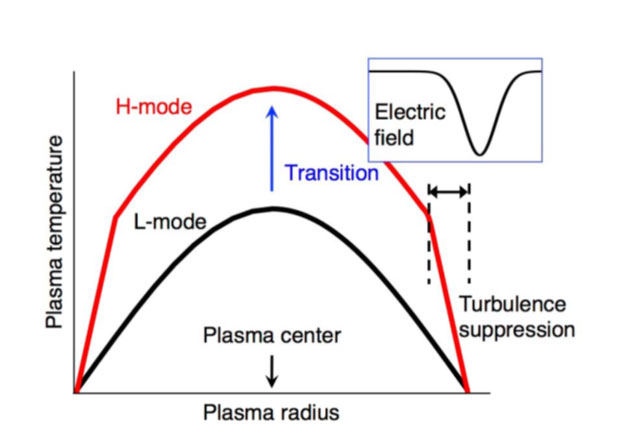HOME > Research Activities > Research Updates >
In order to achieve fusion energy it is necessary to confine high-temperature plasma. However, when we heat plasma, a small spiral flow is generated, and there appear the problems of worsening of plasma confinement and avoiding a rise in temperature. Because the different directions and sizes of the spiral flow are varied and disturbed, this flow is called “turbulence.” When turbulence is present, the plasma with a high core temperature is expelled to outside. A key to solving this problem is the phenomenon called the “H-mode” which improves plasma confinement.
H-mode was accidentally discovered in an experimental device in Germany in 1982. When generating a plasma under certain conditions, we learned that in the plasma edge region confinement is improved by suppressing the turbulence, and the condition in which the whole plasma temperature was raised by an increase at the edge was achieved as shown in the image below. (Regarding this, a plasma with much turbulence and low temperature is called an “L-mode” plasma.) Subsequently, H-mode plasma was reproduced in experimental devices around the world. At the International Thermonuclear Experimental Reactor (ITER), which is expected to begin operation in 2020, it has been decided that H-mode will be the standard operation condition for plasma.
Numerous attempts to clarify the nature of H-mode plasma have been undertaken by many researchers. In 1987, an extremely strong electric field was generated in the edge region of an H-mode plasma, and it was theoretically predicted that the electric field suppressed the turbulence. Subsequently, the actual existence of this strong electric field was indicated using a diagnostic device that was at the cutting edge at that time. The remaining riddle was how this electric field was generated. Research on this topic was advancing from the time of the discovery of the H-mode, but the issue had not been clarified over the past thirty years. Here, we have gained results regarding this riddle.
In order to clarify the mechanism of the generation of the electric field, detailed diagnostic data regarding the electric field inside the plasma and the turbulence is necessary. At the National Institute for Fusion Science we have played a leading role in the development of the Heavy Ion Beam Probe (HIBP) for diagnostics regarding the electric field. (For details, see back numbers 208 and 258.) The HIBP has been used not only in the Large Helical Device, but also in the medium-scale tokamak JFT-2M of the National Institutes for Quantum and Radiological Science and Technology. The JFT-2M is a device that has already been shut down, but high quality data regarding the electric field structure in H-mode plasma was obtained using the HIBP. On the other hand, in recent years methods for theory regarding plasma turbulence and for data analysis have advanced remarkably. Thus, here, using the newest analytical methods, we conducted analyses of experimental data obtained from the JFT-2M in 1999 and determined the method by which the electric field was generated.
In a high-temperature plasma, ions having the positive electrical charge and electrons having the negative electrical charge are moving about. Because ions and electrons have characteristics that pull the other electrically against the fleeing motion of ions and electrons, they repeat the condition in which they maintain distance from the other. In such a condition a strong electric field cannot be generated inside the plasma. (This condition corresponds to L-mode plasma.) When the plasma changes to H-mode, a very slight displacement appears in the distribution of ions and electrons, and an electric field is formed. Many candidates have been forwarded as the candidate for mechanism that forces the appearance of this “displacement.” However, which mechanism is most important had not been clarified. In the analysis presented here, we have clarified the especially important role performed by the effect born from the differences in the confinement orbits of electrons and ions.
The research results presented here were obtained from the moderate scale JFT-2M. Whether these results can be obtained from a large-scale experimental device such as the LHD is necessary to investigate in the future. In a large-scale experimental device diagnostics for the electric field and turbulence will become even more difficult, however, if the physical mechanisms of H-mode plasma can be clarified, the realization of fusion energy generation will become closer.

Characteristics of L-mode Plasma and H-mode Plasma
